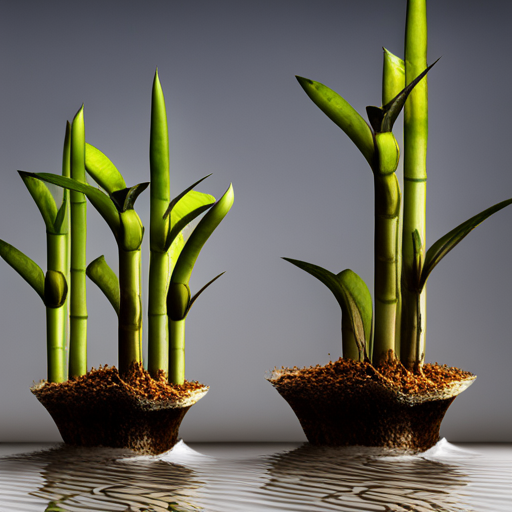Understanding the causes of rot and recognizing the symptoms of an unhealthy bamboo plant is crucial in preventing this deterioration. Factors such as bacteria or fungus in the roots, improper fertilizers, insufficient water or sunlight, and unsuitable temperature can all contribute to the decline of lucky bamboo.
By implementing a few simple tips for proper care, such as avoiding overwatering, limiting exposure to direct sunlight, and maintaining suitable temperature conditions, it is possible to save and restore an unhealthy bamboo plant.
In this article, we will explore the causes of rot, identify the symptoms of an unhealthy bamboo plant, and provide valuable advice on how to keep lucky bamboo thriving and free from rot.
Contents
Our Highlighted Points
- Unhealthy lucky bamboo is caused by bacteria or fungus in the roots.
- Signs of unhealthy lucky bamboo include yellow coloring on the leaves, brown stems, and slimy roots.
- Proper care includes using suitable fertilizers, providing sufficient water and sunlight, and maintaining the correct temperature.
What Causes Rot?

Rot in lucky bamboo plants can be caused by bacteria or fungus in the roots, leading to yellow coloring on the leaves, brown stems, and slimy roots, which are clear signs of an unhealthy bamboo plant. Common causes of rot in lucky bamboo include:
- Improper fertilizers
- Insufficient water or sunlight
- Unsuitable temperature
Overwatering, exposure to direct sunlight, temperature shifts, and over-fertilization can also contribute to rot. To prevent rot in lucky bamboo, it is important to:
- Regularly replace the water
- Clean the container
- Avoid fertilizer residues
Using chlorinated tap water should be avoided, and correct indoor temperatures should be maintained. It is also crucial to regularly check the soil moisture levels to avoid overwatering or underwatering. Fertilization should be done sparingly, only once or twice a year. Additionally, pruning dying or dead leaves and stems, as well as checking for and removing insects, can help maintain the health of the plant.
Symptoms of Unhealthy Bamboo

Symptoms of an unhealthy bamboo plant include yellow or beige coloring on the leaves, dryness, easy breakage, and slimy roots. These signs indicate various issues that can lead to the deterioration of the plant. Common causes of unhealthy bamboo include improper fertilizers, insufficient water or sunlight, and unsuitable temperatures.
Overwatering, exposure to direct sunlight, temperature shifts, and over-fertilization can also result in yellowing leaves and stems. To prevent rot in lucky bamboo, it is crucial to regularly check soil moisture levels and avoid overwatering or underwatering. Fertilization should be done sparingly, only once or twice a year.
Pruning dying or dead leaves and stems, as well as regularly checking for insects and removing them, can help maintain the plant’s health. Additionally, providing bright, filtered, or indirect sunlight, similar to a rainforest environment, is ideal for unhealthy bamboo.
Tips for Proper Care

To ensure the health of bamboo plants, it is important to follow certain care practices. Proper care includes regular pruning and the use of suitable fertilizers. Pruning is essential to remove dying or dead leaves and stems, allowing the plant to focus its energy on healthy growth. It is recommended to prune the bamboo at a 45-degree angle to prevent water from pooling on the cut surface. When it comes to fertilizers, using the best fertilizer for bamboo is crucial. A balanced, slow-release fertilizer with a higher nitrogen content is ideal for promoting healthy growth. It is important to follow the instructions provided on the fertilizer packaging for proper application. By implementing these tips for pruning and using the right fertilizer, the health of bamboo plants can be effectively maintained.
| Tips for Pruning | Best Fertilizer for Bamboo |
|---|---|
| Regularly prune dying or dead leaves and stems | Use a balanced, slow-release fertilizer with higher nitrogen content |
| Prune at a 45-degree angle to prevent water pooling | Follow instructions on fertilizer packaging for proper application |
| Promotes healthy growth | Maintain a consistent feeding schedule |
| Allows the plant to focus on healthy growth | Avoid over-fertilization |
| Enhances the overall appearance of the plant | Provides essential nutrients for optimal growth |
Is Rotting a Common Issue for Lucky Bamboo Plants and How Can I Prevent It?
Yes, rotting can be a common issue for the lifespan of lucky bamboo plants, especially if they are overwatered or exposed to extreme temperatures. To prevent rot, make sure the plant’s roots are not sitting in water and that it has proper drainage. Choosing the right soil and a suitable pot can also help prevent rot.
Frequently Asked Questions
Can lucky bamboo be grown in water instead of soil?
Lucky bamboo can be grown in water instead of soil. Advantages include easier maintenance, prevention of overwatering, and aesthetic appeal. Disadvantages include the need for regular water changes, potential for root rot, and the requirement for additional nutrients.
How often should I prune my lucky bamboo?
Pruning frequency for lucky bamboo depends on the plant’s growth and condition. It is recommended to prune dying or dead leaves and stems as needed. Pruning techniques involve cutting the unwanted parts close to the main stalk.
Can I use tap water to water my lucky bamboo?
Tap water can be used to water lucky bamboo, but it is recommended to let it sit for 24 hours to allow chlorine to dissipate. Alternatively, filtered water or bottled water can be used to avoid potential issues.
Can lucky bamboo be placed in direct sunlight?
Indirect sunlight is better for lucky bamboo growth. It should not be placed in direct sunlight. Placing lucky bamboo near a window with filtered sunlight is ideal, as excessive light can cause the leaves to stretch or fade in color.
How long does it take for lucky bamboo to grow?
The growth rate of lucky bamboo is influenced by various factors. These include the amount of sunlight, water, and fertilization it receives, as well as the temperature and humidity levels. On average, lucky bamboo can take several months to a few years to reach its full growth potential.

